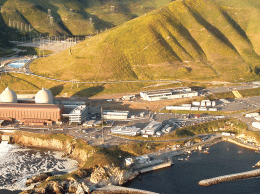By Ed Halpin
Editor’s note: Our March 13 editorial raised questions about PG&E’s recent seismic assessment of the Diablo Canyon nuclear plant near Avila Beach. In response to coverage in the Business Times and other media, PG&E has offered the following commentary.
Diablo Canyon Power Plant plays a major role in helping PG&E generate and deliver to its customers some of the nation’s cleanest electricity.
There’s nothing more important to the company and the 1,500 employees that work at the plant and live with their families in the community than its safe operation. We understand we have been given a special trust to operate the plant and we work to keep that trust by putting safety first.
When it comes to safety, the question I often get asked is, can the plant withstand earthquakes and other forces nature may throw our way? My answer is yes, and it’s based on how the plant is designed and our studies of how earthquakes and tsunamis may impact the plant.
It’s important to remember that it is built to a higher safety standard than other commercial buildings. Unlike these buildings — built to hold up for occupants to escape after an earthquake — Diablo Canyon’s structures were designed to remain intact, with key safety systems continuing to operate, after a major seismic jolt.
Our commitment to plant safety also extends to ensuring it can withstand offshore and weather events, which is why protection from floods and tsunamis was also at the forefront in the design of the facility.
Seismic and tsunami safety wasn’t a one-shot deal with the design and construction of the plant. We constantly work to ensure the facility can withstand such events.
Through our long-term seismic safety research program, we gather new information on how earthquakes behave locally and around the world and have applied that information to ensure plant safety. Our safety focus has also led us to continue our study of tsunamis, including how they are generated, their source, and what impact they might have to the facility.
These topics took on even more importance in 2011, following the events at the Fukushima Daiichi power plant in Japan. While the plant there stood up well in the face of a major earthquake, the resulting tsunami caused a series of events that led to the accident at the facility.
Since Fukushima, the U.S. Nuclear Regulatory Commission and the nuclear industry have implemented numerous changes to ensure that all U.S. facilities, including Diablo Canyon, can withstand extreme events. This includes adding additional layers of back-up equipment to provide continuous electricity and cooling at all times.
The NRC also required all U.S. plants to re-evaluate the potential hazard that earthquakes and flooding pose to their facilities. We recently completed a reassessment of these hazards and the results reflect well for Diablo Canyon. The extensive scientific analyses continue to show that the plant can safely withstand earthquakes, as well as large waves and flooding that could potentially occur in the region.
Under the NRC’s seismic hazard re-evaluation process, independent experts publicly analyzed existing and new seismic information, including how earthquakes occurring on individual and multiple geologic faults could potentially impact the facility. Their work also included an evaluation of the advanced seismic studies recently performed near Diablo Canyon, as well as feedback on the research provided from a state-appointed independent peer review panel.
The result is a thorough assessment of the seismic hazard, confirming the plant continues to be seismically safe.
Our flooding and tsunami hazard update involved the use of the latest NRC guidance and methodologies to determine the maximum potential waves and rainfall that could impact the site.
The re-evaluation, using independent expertise, determined that the plant’s key safety systems and components continue to be safe from tsunamis.
The plant’s design is also deemed appropriate to withstand expected storm flooding. In addition, measures were identified and implemented to address a rare, theoretical event of excessive rainfall and a quick build-up of water in some plant locations that greatly exceeds any known precipitation event recorded in the site’s history.
These assessments will now be reviewed by the NRC and are available to researchers and the public who are interested in learning more about the findings.
While these important updates demonstrate the plant’s design is safe, our work doesn’t stop there. Our commitment to safe operations and always protecting public health and safety will continue to be reflected in our ongoing study and evaluation of the areas. You, our customers and our neighbors expect no less.
We encourage anyone who wants to learn more about the plant and our commitment to safety to take one of our public tours. For more information, please visit www.diablocanyonpge.com.
• Ed Halpin is senior vice president and chief nuclear officer at PG&E, whose service area includes San Luis Obispo County and North Santa Barbara County.






 Print
Print Email
Email

















